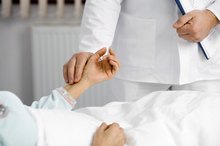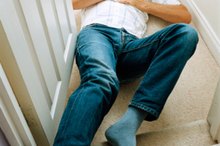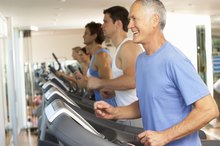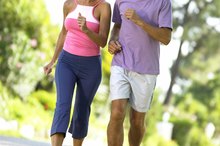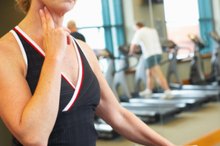Heart Pain After Using a Treadmill
Regular exercise such as treadmill running is important for cardiovascular health. When heart pain interferes with your ability to exercise, though, you may start avoiding workouts. The resulting lack of activity could worsen your health over time. Heart pain during exercise isn't the equivalent of a heart attack, but it is cause for concern. If you experience heart pain while on a treadmill, stop to rest and consult a health care provider.
If you are experiencing serious medical symptoms, seek emergency treatment immediately.
Angina Pectoris
Angina pectoris is chest or heart pain that occurs when a part of the heart doesn't receive enough blood and therefore oxygen to function properly. You may feel a squeezing pain in your chest as well as pain along your arms, neck or back. This pain goes away after a few minutes of rest. Because the heart's oxygen requirements increase during vigorous physical activity, like treadmill running, angina is more likely to occur when you exercise. Medical professionals refer to angina that occurs during exercise as stable angina and say it is fairly predictable 1.
- Angina pectoris is chest or heart pain that occurs when a part of the heart doesn't receive enough blood and therefore oxygen to function properly.
- Because the heart's oxygen requirements increase during vigorous physical activity, like treadmill running, angina is more likely to occur when you exercise.
The Treadmill Stress Test
Heart Flutters Symptoms
Learn More
Your health care provider may use a treadmill stress test to learn more about the causes of your heart pain. During this test, a health care technician will fasten electrodes to your chest to monitor your heart activity through an electrocardiogram. The technician will ask you to walk briskly on a treadmill or ride a stationary bike for about five to 15 minutes. You'll need to let the technician know if you experience any symptoms including heart pain, muscle pain or shortness of breath. Alternatively, your health care provider may order cardiovascular magnetic resonance imaging, coronary catheterization or other tests to assess your heart pain.
- Your health care provider may use a treadmill stress test to learn more about the causes of your heart pain.
- During this test, a health care technician will fasten electrodes to your chest to monitor your heart activity through an electrocardiogram.
Managing Heart Pain
Unlike unstable angina, which occurs at unpredictable times, stable angina isn't a sign of an impending heart attack. It does, however, indicate a cardiovascular problem that requires medical attention 1. Coronary heart disease is the most common cause of angina, note University of Maryland Medical Center experts. You can start improving your cardiovascular health and reducing your angina risk by making lifestyle changes. These include eating less saturated fat or getting regular moderate exercise. Your health care provider may also prescribe medication such as nitroglycerin.
- Unlike unstable angina, which occurs at unpredictable times, stable angina isn't a sign of an impending heart attack.
- It does, however, indicate a cardiovascular problem that requires medical attention 1.
Exercising Without Pain
What Are the Treatments for Cardiomegaly?
Learn More
At least 30 minutes of moderate intensity exercise five days a week is appropriate for people who have experienced exercise-induced angina, University of Maryland Medical Center experts advise. You may need to start with 20-minute workouts two or three days weekly and work up to more frequent exercise. To prevent an angina attack, avoid intense exercise and activities that involve fast movements. Walking briskly on a treadmill is still an option, but avoid running. Moderate-intensity cycling and swimming are also safe options.
- At least 30 minutes of moderate intensity exercise five days a week is appropriate for people who have experienced exercise-induced angina, University of Maryland Medical Center experts advise.
- To prevent an angina attack, avoid intense exercise and activities that involve fast movements.
Related Articles
References
- Dartmouth Medical School: Patient Resources — Conditions — Angina
- Jones MM, Somerville C, Feder G, Foster G. Patients' descriptions of angina symptoms: a qualitative study of primary care patients. Br J Gen Pract. 2010;60(579):735-41. doi:10.3399/bjgp10X532378
- Wang J, Xiong X, Feng B. Effect of crataegus usage in cardiovascular disease prevention: an evidence-based approach. Evid Based Complement Alternat Med. 2013;2013:149363. doi:10.1155/2013/149363
- Mingorance C, Rodríguez-rodríguez R, Justo ML, Alvarez de sotomayor M, Herrera MD. Critical update for the clinical use of L-carnitine analogs in cardiometabolic disorders. Vasc Health Risk Manag. 2011;7:169-76. doi:10.2147/VHRM.S14356
- Yang K. A review of yoga programs for four leading risk factors of chronic diseases. Evid Based Complement Alternat Med. 2007;4(4):487-91. doi:10.1093/ecam/nem154
- Rafieian-kopaei M, Setorki M, Doudi M, Baradaran A, Nasri H. Atherosclerosis: process, indicators, risk factors and new hopes. Int J Prev Med. 2014;5(8):927-46
- Kones R. Recent advances in the management of chronic stable angina I: approach to the patient, diagnosis, pathophysiology, risk stratification, and gender disparities. Vasc Health Risk Manag. 2010;6:635-56. doi:10.2147/vhrm.s7564
- Ahumada C, Sáenz T, García D, De La Puerta R, Fernandez A, Martinez E. "The Effects of a Triterpene Fraction Isolated From Crataegus Monogyna Jacq. on Different Acute Inflammation Models in Rats and Mice. Leucocyte Migration and Phospholipase a2 Inhibition. " J Pharm Pharmacol. 1997 49(3):329-31.
- Iwamoto M, Sato T, Ishizaki T. "The Clinical Effect of Crataegutt in Heart Disease of Ischemic or Hypertensive Origin. a Multicenter Double-Blind Study. " Planta Med. 1981 42(1):1-16.
- Iyer RN, Khan AA, Gupta A, Vajifdar BU, Lokhandwala YY. "L-Carnitine Moderately Improves the Exercise Tolerance in Chronic Stable Angina." J Assoc Physicians India. 2000 48(11):1050-2.
- Mahajan AS, Reddy KS, Sachdeva U. "Lipid Profile of Coronary Risk Subjects Following Yogic Lifestyle Intervention." Indian Heart J. 1999 51(1):37-40.
Writer Bio
Nicole Langton has been a professional writer for over 10 years. She began writing for a natural health company where she developed a deep interest in nutrition and natural treatments. Langton earned a Bachelor of Arts in east central European studies as well as a certificate in English language to teach to adults.


